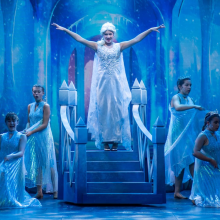Filichia Features: A Neuro-Inclusive LITTLE SHOP OF HORRORS

Filichia Features: A Neuro-Inclusive LITTLE SHOP OF HORRORS
Said the placard in the lobby “EPIC Players, a neuro-inclusive theatre company, presents a neuro-diverse Little Shop of Horrors.”
“Neurodiversity” refers to variations in the brain regarding sociability, learning, attention, and mood; thus “neuro-inclusive” means those who meet that description will be participating in this production of the Howard Ashman-Alan Menken smash-hit.
EPIC executive artistic director Aubrie Therrien (who also staged the show) told me “The cast is 75% neuro-diverse, mostly living on the autism spectrum. The majority of our leads live on the spectrum.”
Nicole D’Angelo, who played Audrey, wrote in her program bio that she “was diagnosed with Asperger Syndrome at the age of 16 and is very passionate advocating for autistic women like herself.”
In her program notes, Therrien agreed: “It is our hope that this production – and all of our work – will continue to push the boundaries of inclusion in the arts, break through social barriers and debunk long-held stigmas about the community we serve.”
And did EPIC do just that. D’Angelo and all the others were extraordinary – and this was a dress rehearsal, yet.
All those aspects of autism we hear about, such as a preference for solitude? Hardly, with 22 on stage.
Avoidance of eye contact? No problem for even one performer; each looked directly at us when the show demanded it.
Unusual and intense reactions to sounds, textures, lights and colors? After five months of rehearsal, all 22 did the job fearlessly despite swirling lights, vivid colors and Audrey II’s now-famous burp.
Two performers were Equity members, including Ben Rosloff who expertly played Seymour. When he sang “Can you imagine me giving lectures?” we could indeed. He had no trouble with the lickety-split patter in “Now (It’s Just the Gas)” and proved he’d be a terrific Leo in The Producers, which EPIC should now consider.
Ronette, Crystal and Chiffon were buttressed by two other performers. This quintet would certainly have pleased Zach in A Chorus Line who demanded that his ensemble move as one; these five certainly did with every crisp gesture.
The invited audience mostly consisted of students from District 75, which caters to autistic individuals. Thus, Therrien’s pre-show speech included a trigger warning – that if anything on stage unnerved anyone, “we welcome you to exit the space at any time during the production to decompress in the lobby. We will also have noise-canceling headphones on hand for any audience members experiencing sensory over-stimulation.”
Despite the thunder and lightning effects, gunfire, out-and-out-violence and grisly deaths, only two individuals (out of the four dozen or so spectators) took their leave. During Orin Scrivello, D.D.S.’s “Dentist” – which could scare anyone – a young man walked out but returned after the song had concluded.
Another lad did the same when the plant loudly demanded “Feed Me” but the boy apparently only needed a breather; he returned before the song was over.
Perhaps both felt they wouldn’t want to miss too much of this very entertaining production.
As has been the case with so many recent productions, the voracious Audrey II was played by a performer rather than a puppet. Nick Moscato was dressed in green and purple from wig to toe and had a marvelous time with the words and music.
These weren’t the only achievements of this Little Shop. Therrien’s production offered smart ideas. Positioned above the set were two screens where, before the show, snippets of black-and-white schlocky horror films were shown to put us in the appropriate mood.
Remember how The Rocky Horror Picture Show started with just a film of lips singing its opening song? Here the pre-show narration (“On the 21st day of the month of September in an early year of a decade …”) used those lips, too.
Therrien also showed attention to detail. Early in Act Two, Mr. Mushnik told Seymour that the police, when investigating Orin’s disappearance, “found a Mushnik’s Skid Row Florists bag in his office.” Indeed, I’d noticed in that previous office scene that a bag had been imprinted with the words and the logo.
“Don’t Feed the Plants,” the finale, usually has the actual faces of Seymour, Audrey, Mushnik and Orin interspersed among Audrey II’s vines. Here the point was effectively suggested when the entire cast came out with green wigs -- and made galvanic eye contact.
If you’re at all involved with autistic individuals and have considered producing a show starring them, do it. Let EPIC’s epic success with Little Shop of Horrors be an inspiration to all.
You may e-mail Peter at pfilichia@aol.com. Check out his weekly column each Monday at www.broadwayselect.com and Tuesday at www.masterworksbroadway.com. He can be heard most weeks of the year on www.broadwayradio.com.
Follow the fun @mtishows on Instagram, Facebook, and Twitter.

























